limbic system pt 1
1/30
There's no tags or description
Looks like no tags are added yet.
Name | Mastery | Learn | Test | Matching | Spaced |
|---|
No study sessions yet.
31 Terms
overview
limbic system participates in complex behaviors such as __ & __, and it is thought to be the neuro-anatomical substrate for __, __, and __ aspects of behavior
includes both __ and __ structures
the limbic system is divided into __ levels
memory; learning
emotional; drive-related; motivated
cortical; subcortical
2
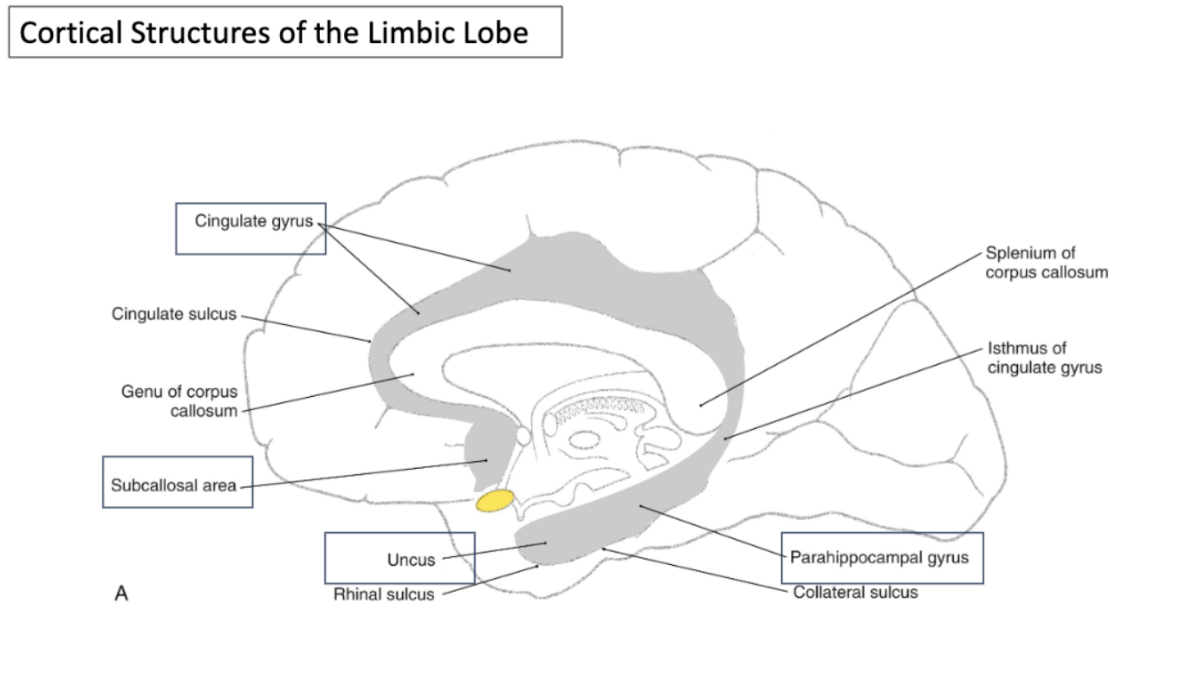
first level of the limbic system: cortical structures of the limbic lobe
limbic lobe (structures are interconnected)
subcallosal area
projects to the amygdala
involved in the suppression of fear responses
also has autonomic functions, such as regulation of heart rate, blood pressure, and stress hormones (e.g. cortisol)
cingulate gyrus
involved in emotional processing and regulation
parahippocampal gyrus (entorhinal cortex)
involved in memory and coding, especially spatial memory and retrieval
uncus
involved in olfactory processing, processing of emotions, and emotional regulation
hippocampal formation
involved in declarative memory formation
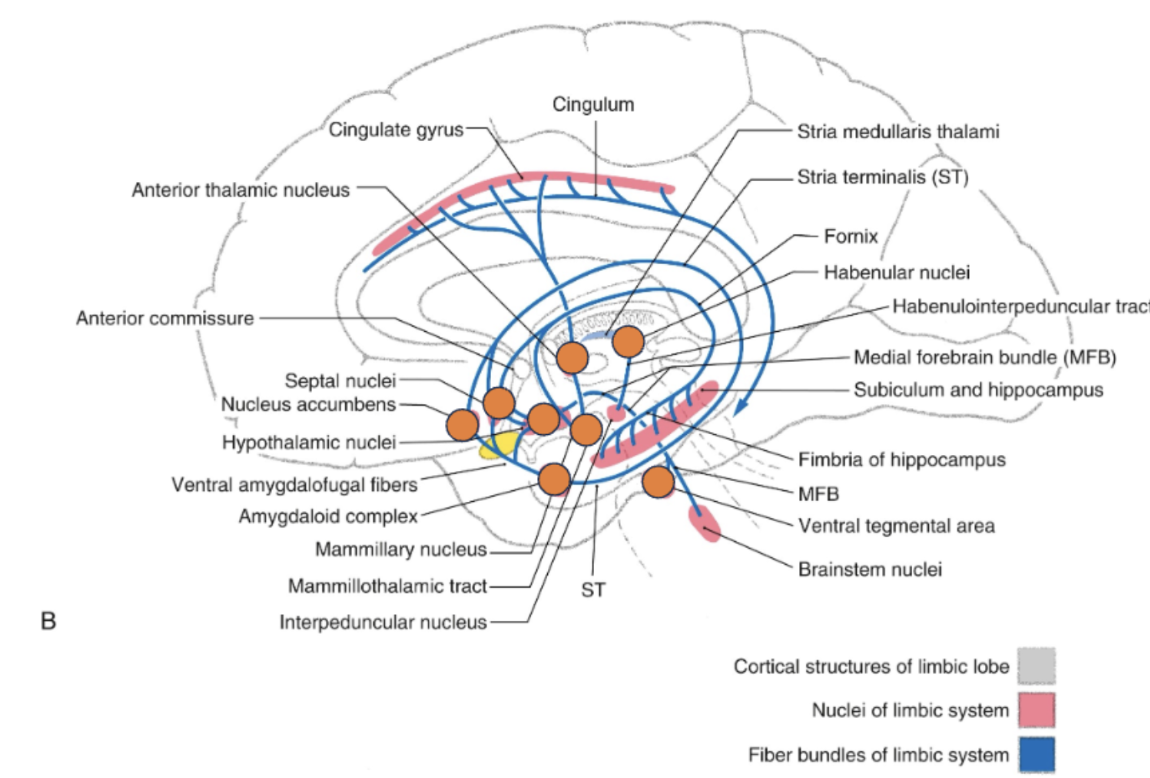
second level of the limbic system
these structures are interconnected with each other and the structures of the limbic lobe
prefrontal & orbitofrontal cortex
conscious perception of emotions and emotional regulation (e.g., feeling happy or sad)
amygdala
plays a major role in emotions and drive-related behaviors
associative learning
formation of emotional memories
septal nuclei
associated with reward mechanisms
involved in reward circuitry
nucleus accumbens (apart of ventral striatum) & ventral pallidum
associated with reward mechanisms
part of limbic loop (reward circuitry) that may gate the initiation and termination of appropriate behavioral responses
hypothalamic nuclei (esp. mammillary bodies)
important role in producing the visceral responses to emotions
midbrain (ventral tegmental area)
important source of dopamine for reward circuit
thalamic nuclei
integrate and gate information flow to cortex
habenular nuclei
play a role in control of emotional and social behaviors related to pain, stress, and anxiety
also plays a role in sleep
== limbic system connects the neocortex & the hypothalamus, forming a functional link between endocrine, visceral, emotional, & voluntary responses to the environment
memory and learning
learning:
memory:
normal ability to learn, store, and retrieve information is critical to
everyday life and disruption of this normal ability can have profound
effects on engagement in occupation
learning: acquisition of knowledge
memory: retention of learned information; ability to retain information
over timeencoding
where sensory input is changed into a form the brain can process (e.g., visual information, acoustic information/sound, semantic information/meaning)
consolidation/storage
involves…
how long the memory lasts for
how much information can be stored at any time, i.e., capacity
what type of information is being held
retrieval
getting information out of storage so that it can be used
memory and learning
immediate memory:
short term memory:
long-term memory:
immediate memory: memory that spans seconds; sensory perception (the perception of sensory stimuli)
someone says hello —> we hear and perceive that someone said hello
short term memory: (aka working memory) involves the short-term maintenance of information in memory & the manipulation of information to achieve an immediate goal (e.g., retaining the phone number you just looked up to order pizza!) —> thought to be dependent on the prefrontal cortex (esp, the dorsolateral prefrontal cortex)
“short term memory” and “working memory" are often used interchangeably, but when they aren’t…
short term memory: the simple maintenance of information
working memory: may involve manipulating information in more complex tasks
both are needed for various tasks that require…
performing multiple tasks simultaneously
doing mental calculations
understanding long written or spoken sentences (e.g., listening to a lecture)
long-term memory: memory that spans days, months & years
2 types: declarative (explicit) and non-declarative (implicit)
long-term memory
declarative:
(aka explicit memory) memories of facts and events that can be consciously recalled and verbalized (“who, what, when & where”) —> stored in the hippocampus
semantic memory: involves the knowledge of facts
e.g., knowing the categories of objects (e.g., apples and bananas are fruits)
e.g., knowing historical events (e.g., George Washington was the 1st president of the U.S.)
episodic memory: involves memory of personal events and experiences
includes the ability to learn, store, and retrieve information about personal experiences attached to a specific event, including the time, place and details of the events (e.g., knowing information about your prom)
long-term memory
non-declarative:
(aka implicit or procedural memory) memories that cannot be consciously recalled or verbalized – subconscious behavioral or physiological response to events or stimuli
memories for skills & habits (procedural memory): “knowing how to do it” or “motor memory” —> basal nuclei & cerebellum are involved
e.g., riding a bike, swimming, driving
asssociative learning: stimulus-response learning, in which a new response becomes associated with a particular stimulus (e.g., classical conditioning)
includes emotional associations: (aka “emotional memories”) changes in behavior toward a previously neutral stimulus secondary to experience —> amygdala
e.g., fear & reward (e.g, seeing a dog —> fear; seeing a dog —> feeling joy/have a rewarding experience)
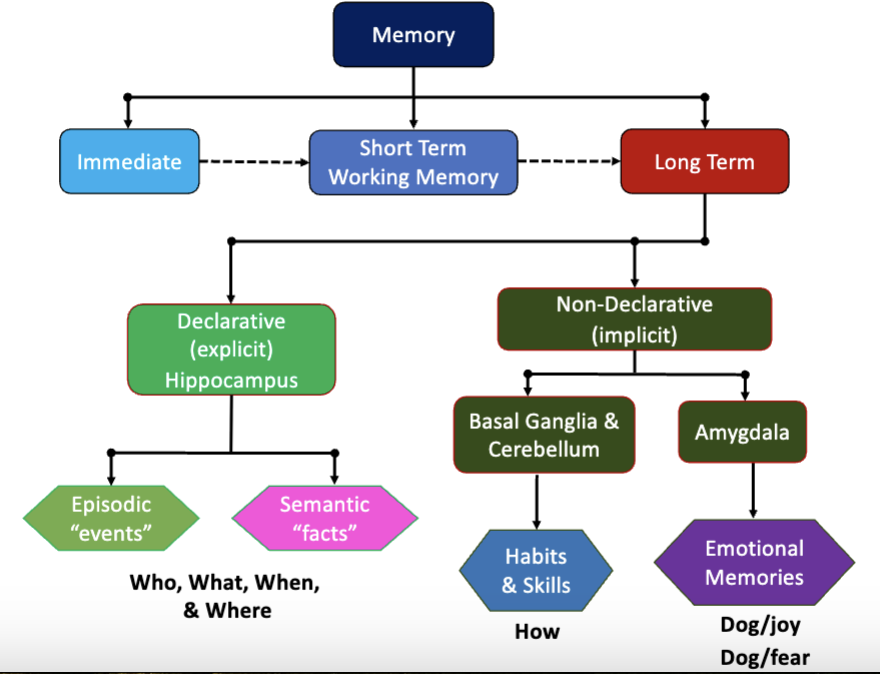
flow chart for different types of memories
immediate
initial perspective of environmental stimuli
short term, working memory
information used in simple or complex tasks
information that we can remember for longer periods (e.g., days, weeks, months, years)
long term
can be declarative (things that are verbalized)
explicit memories (who, what, where, when) that are encoded in the hippocampus
episodic events, or
semantic events
can be non-declarative (motor skills and associations)
implicit memories that are not consciously recalled
motor memories (how), like habits and skills, encoded in the basal ganglia and the cerebellum- how to do something
emotional memories, in which a neutral stimulus is paired with an emotion- associative learning (dog/fear; dog/joy)
hippocampal formation (aka Hippocampus):
3 zones:
plays a major role in the mediation of learning and declarative memory formation
hippocampus is divided into 3 zones:
subiculum: transition zone of cortex that is continuous with the hippocampus on one side & the para-hippocampal gyrus on the other side
hippocampus proper: consists of gray matter and a thin sheet of white matter (alveus) which are the axons of the cell bodies located in the subiculum and the hippocampus proper
dentate gyrus: area of gray matter that lies between the fimbria & the parahippocampal gyrus
image: sagittal view of the hippocampus in relation to the lateral ventricle
C-shaped structure located deep within the medial temporal lobe
hippocampus is connected to the fornix, which is connected to the mammillary bodies of the hypothalamus
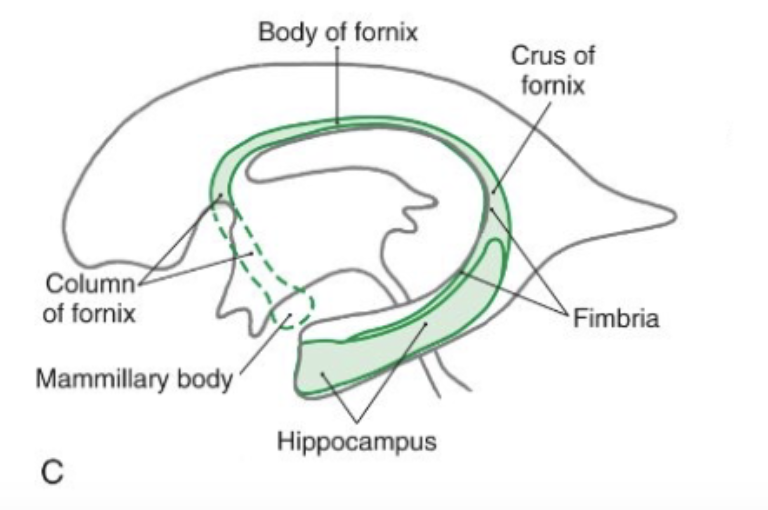
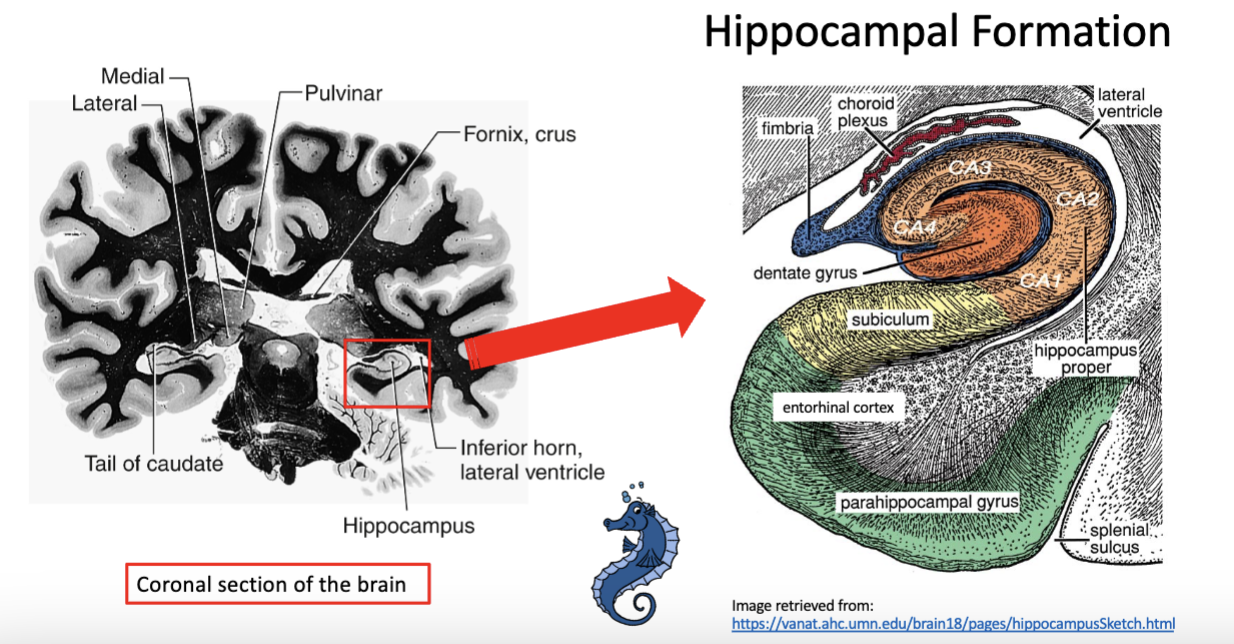
specific structures of the hippocampal formation
subiculum (yellow): transition zone of cortex that is continuous with the hippocampus on one side & the para-hippocampal gyrus (green) on the other side
hippocampus proper (light orange): consists of gray matter and a thin sheet of white matter (alveus), which are the axons of the cell bodies located in the subiculum and the hippocampus proper
dentate gyrus (darker orange): area of gray matter that lies between the fimbria & the parahippocampal gyrus
only place where new cells are generated
thought to be instrumental in the formation of new memories
hippocampal formation
neural circuitry:
afferent pathways:
efferent pathways:
afferent pathways:
perforant pathway (green lines): hippocampus receives the majority of its input from the parahippocampal gyrus (entorhinal cortex) via the perforant pathway– most fibers terminate on the granule cells of the dentate gyrus, i.e., this is where the information is sent
—> granule cells of the dentate gyrus then project to the hippocampus proper,
—> which then provides input into the subiculum
subiculum also receives input from the amygdala
efferent pathways:
output from the hippocampus originates predominantly from the subiculum and some of the pyramidal cells of the hippocampus proper
fornix – major efferent pathway of the hippocampus
fibers from the subiculum project via the fornix to the medial mammillary nucleus (mammillary bodies of the hypothalamus)
fibers from the hippocampus proper project via the fornix to the septal nuclei, the medial frontal cortex, hypothalamic nuclei, and the nucleus accumbens
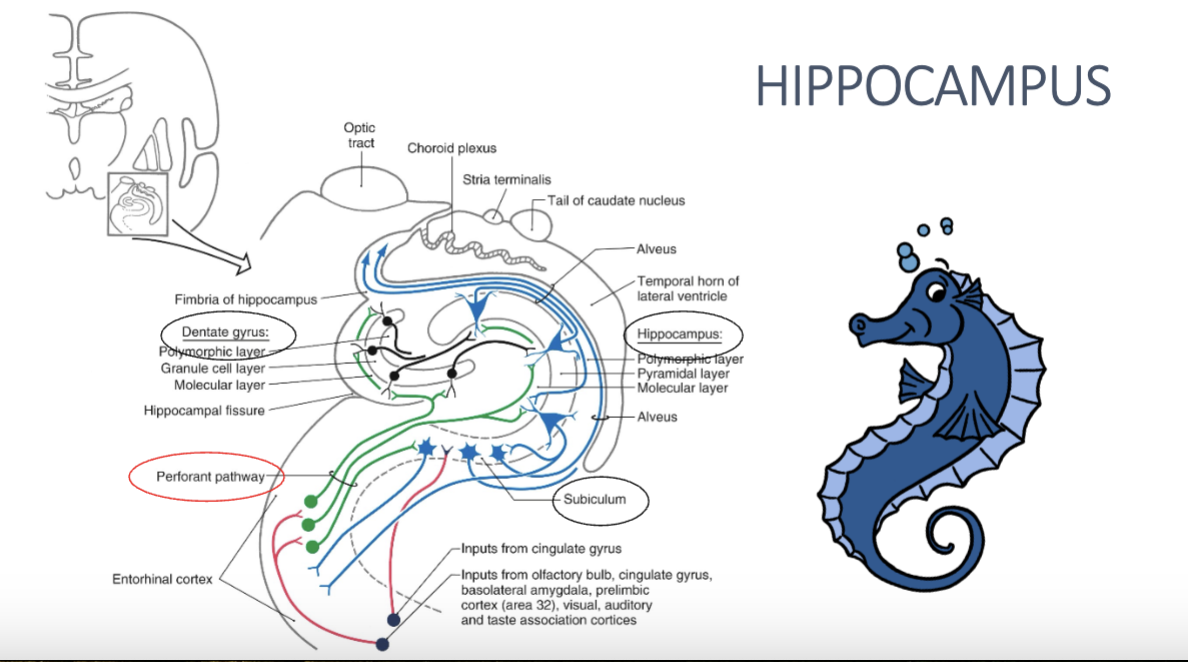
long-term potentiation
short term memories are consolidated into long-term memories through a process called long-term potentiation (LTP)
LTP causes long-term strengthening of the synapse between two neurons that were activated at the same time: “cells that fire together – wire together”
results in neuroplasticity
low-frequency stimulus: glutamate released from presynaptic cell binds both NMDA & AMPA receptor types; activates AMPA receptor but insufficient to activate NMDA
high-frequency stimulus: synaptic inputs (excitatory post-synaptic potentials - EPSPs) are spatially & temporally summed causing significant depolarization of the post synaptic cell membrane resulting in (removal of Mg++) activating NMDA receptor on the post-synaptic neuron
glutamate released at the perforant pathway activates NMDA receptors in hippocampal cells that allow an increased number of Ca2+ (calcium) ions to enter the cell
Ca2+ influx causes biochemical changes (e.g., the insertion of more glutamate receptors into the post-synaptic membrane, greater neurotransmitter release, dendritic spine growth, etc.) in the cell that trigger long-term changes
—> results in synaptic plasticity: the more the circuit is activated, the easier it is to activate it, resulting in learning and memory
==> long term memories are then ultimately stored in the cortex

clinical notes: disorders that involve memory impairment
alzheimer disease
early disease process: characterized by the progressive loss of declarative memory with poor recall of recent events & difficulty with new learning
late disease process: loss of long-term memory & behavioral changes later in the disease process; non-declarative memory is relatively spared
this disease causes neuronal loss in the hippocampus and parahippocampal gyrus
clinical notes: disorders that involve memory impairment
korsakoff’s syndrome:
results from thiamine deficiency; caused by alcohol abuse, dietary deficiencies, or the effects of chemotherapy
characterized by loss of short-term memory, an inability to establish long-term memory for new events and confabulation
neuronal loss is seen in the mammillary region of the hypothalamus and the hippocampus
clinical notes: disorders that involve memory impairment
temporal lobe epilepsy:
hippocampus is a frequent site of recurrent seizure activity, which may result in progressive memory impairment and changes in emotional behavior
emotions: historical perspective
James-Lange (1800s): William James and Carl Lange
suggested emotions occur as the direct result of a physiological reaction to an external stimulus or event
e.g., we see a bear in the woods (external stimulus), and we have a physiological response to that stimulus (e.g., fight or flight response); the interpretation of that response results in the emotional experience (e.g.,
fear)
emotions: historical perspective
Cannon-Bard (~1920-1930s): Walter Cannon and Philip Bard
Challenged James-Lange
we can have physiological reactions without emotional responses
e.g., increased heart rate with exercise, but no emotional experience
the same physiological reaction may occur with different emotional experiences
e.g., heart racing w/ fear; heart racing w/ excitement; cry w/ joy; cry w/ sadness
emotional experience happens too quickly for it to be purely a byproduct of the physiological reactions
proposed the two occur together + there are links between brain regions that cause both the emotional experience and physiological reactions
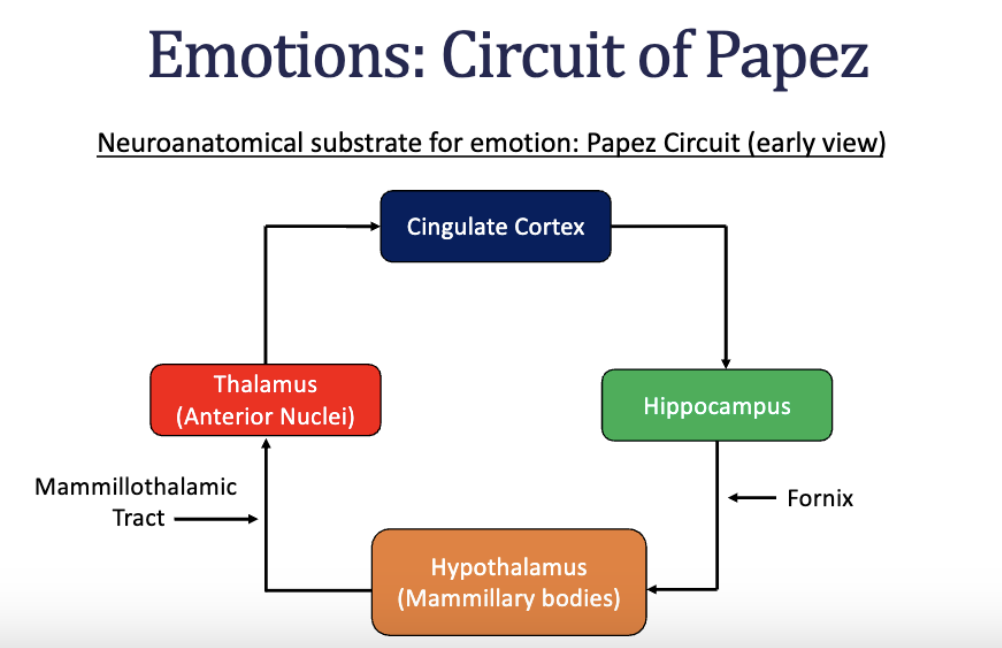
Dr. Papez proposed that the experience of emotion involves reciprocal connections between the diencephalon and the cortex
connections between the hypothalamus and the cortex forms the neuroanatomical substrate of emotions- called the circuit of Papez
cortical control over emotions occurs in a loop, originating from the cingulate gyrus
—> cingulate gyrus then projects to the hippocampal formation
—> which then projects to the mammillary bodies, via the fornix
—> which then projects to the anterior nuclei in the thalamus
—> anterior nucleus projects back to the cingulate cortex
== explains the link between emotions and the bodily expression of emotions
*but does not include the amygdala
emotions: historical perspective
Schachter-Singer (1960s)
Stanley Schachter and Jerome Singer – “Two Factor Theory”
combined elements of James-Lange and Cannon-Bard
highlighted the importance of reasoning in emotions
proposed that emotions result from 2 different factors: both (1) physiological and (2) cognitive processes of the body
(1) e.g., activation of the sympathetic nervous system that creates physiological arousal (e.g., increased heart rate, sweating, trembling)
(2) e.g., people try to interpret their physiological response by looking at the surrounding environment to determine the cause (e.g., look around environment to see what is causing your heart to beat faster; e.g., if you saw your friends all around you at a party, your heart likely sped up because you are happy)
when an event causes physiological arousal, we try to find a reason for this arousal; this process results in the experience of emotion and the labeling of the emotion
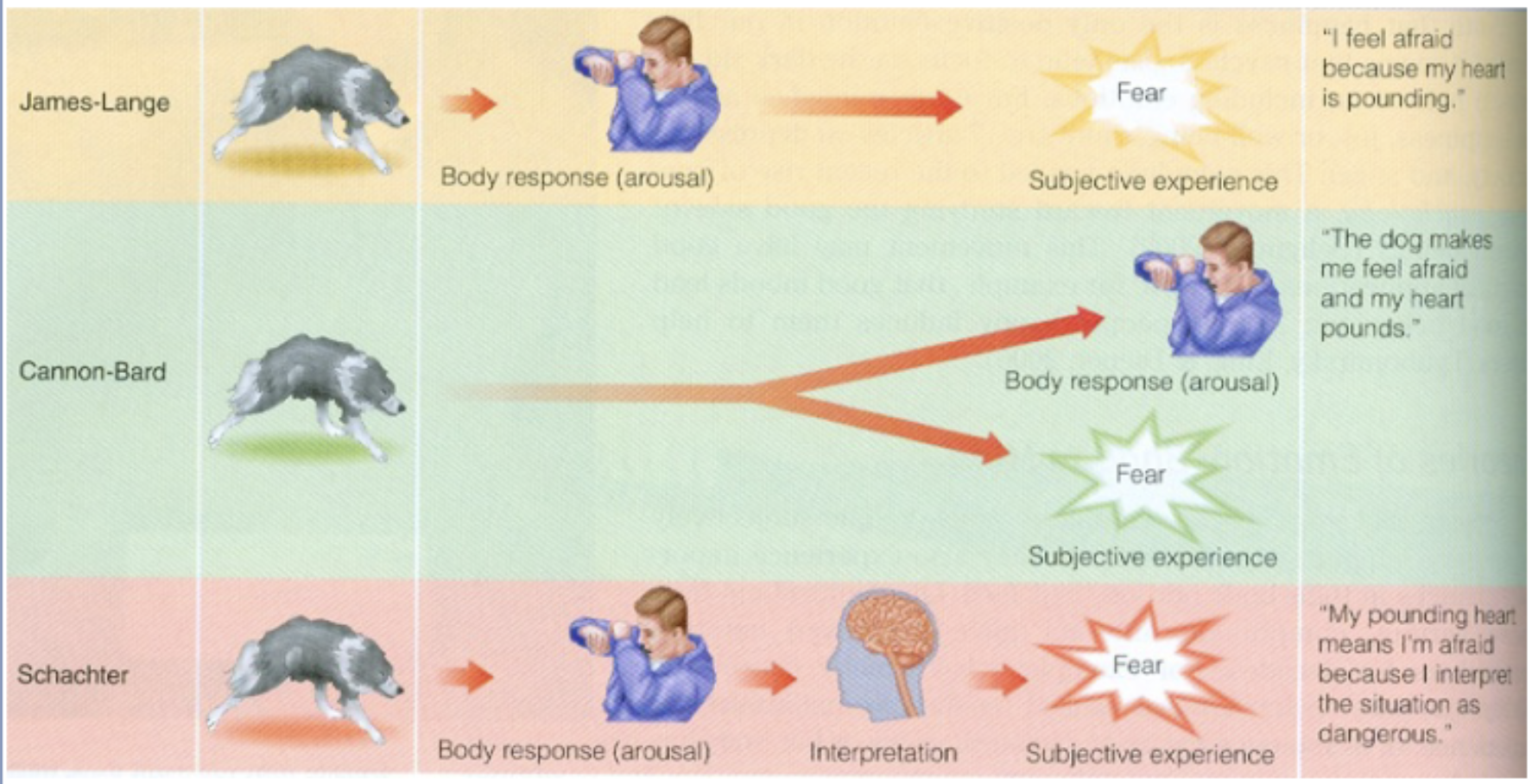
summary of the 3 theories
emotions: current views
higher-order theory of emotional consciousness
recognizes the importance of both physiological and cognitive processes in emotions
suggests that there is parallel-distributed processing in subcortical and cortical circuits that give rise to both (1) conscious perceptions of emotions and (2) bodily responses that are associated with emotions
sub-cortical circuits (aka survival circuits) allow for the implicit evaluation of a stimulus as potentially harmful or beneficial and mobilize adaptive responses that allow us to survive
cortical areas are engaged in the higher-level processing that allow us to ultimately understand and experience the stimulus, leading to the experience of emotions
general networks of cognition (GNCs) allow us to have thoughts and reflect on our own mental states and the states of others
GNCs create “higher order representations” of external stimuli
related to our working memory
requires an extended network of interconnected brain structures
image
in the higher-order theory of emotional consciousness, conscious perception of emotions depends on higher-order representation of sensory information- through cognitive circuits, such as working memory
e.g., see a snake
initially you are startled, so you jump and your heart rate increases (activation of the sub-cortical survival circuits + sympathetic nervous system)
you then realize it is a small harmless snake and it is not a threat; you just start to enjoy watching it
== there is parallel distributive processing for both sub-cortical and cortical circuits, meaning that both of these circuits are processing sensory information to interpret it
we may have activation of the sub-cortical survival circuits, which produce specific brain and body responses
but there are also higher-cortical levels in our long-term memory, working memory, other sites in the limbic system, etc., that are also creating our emotional experience
==> there is feedback between these systems, and they inform one another
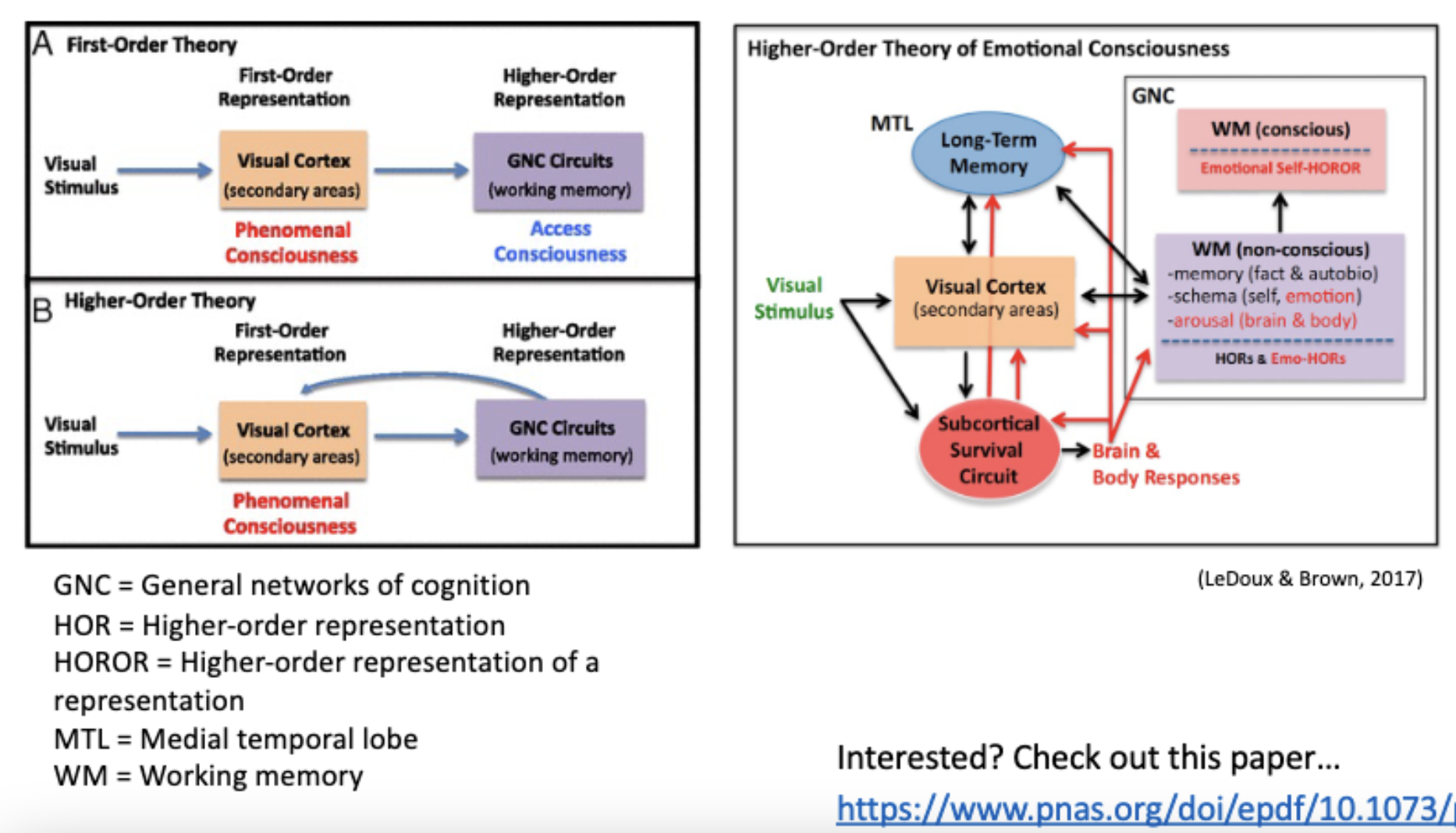
emotions: current views
neuroanatomical substrate of emotions: expanded Papez Circuit - consists of multiple networks that are interconnected
amygdala— key structure in emotional expression, formation of emotional memories, basic drives (fear/reward), associative learning
hippocampus plays a key role in the formation of declarative memories and is involved in emotional processing and regulation (when coupled with the amygdala)
hypothalamus– involved with generating the bodily expressions of emotions, including physiological responses
association areas of the cortex and the prefrontal cortex— play a key role in the conscious experience of emotions and modulating behavior in response to emotions
amygdala
amygdala: functions as an integrative center for emotional behavior
critical for the ability to feel strong emotions, such as fear and pleasure
important for recognizing and interpreting the emotions of others
appears to play a major role in linking perception/memories with visceral & behavioral responses (involved in associative learning)
assesses emotional significance (of different stimuli)
efferents of the amygdala are sent to (different areas of the limbic system):
hypothalamus– regulation of bodily responses to the emotion
dorsomedial nucleus of thalamus and orbitofrontal cortex– conscious perception of emotion
hippocampus and associated cortical areas (medial temporal lobe memory system)– consolidation of emotional memories
clinical notes:
klüver-bucy syndrome
bilateral temporal lobe lesions that abolish the amygdala and adjacent structures (e.g. hippocampus can be involved to varying degrees)
visual agnosia – inability to recognize objects by sight
hyperorality – tendency to examine objects excessively by mouth
placidity – no longer show fear or anger when appropriate to situation
hyperphagia – excessive eating
hypersexuality – suggestive behaviors and suggestive talk
diffuse modulatory systems
collections of neurons that make widely dispersed and diffuse connections throughout the brain; they perform regulatory functions, modulating activity in vast populations of postsynaptic neurons
the core of each system has a small set of neurons (several thousand) that release the same neurotransmitter; they arise predominantly from the brainstem
each neuron of the system can influence many other postsynpatic neurons through a process called divergence (e.g., one presynaptic axon can contact ~ 100,000 postsynaptic neurons throughout the brain)
these systems are important to overall brain function, impacting motor control, memory, mood, motivation, & metabolic state
many psychoactive drugs impact these systems
imbalances in these systems factor into proposed theories of the biological basis of mental illness
diffuse modulatory systems
each associated with a different neurotransmitter
***ventral tegmental area (VTA)/ substantia nigra (SN) —> dopamine
rewards system (VTA)
learning motor skills/habits that produce rewards (SN)
raphe nuclei —> serotonin
involved in control of pain modulation, sleep-wake cycles, mood, and emotional behaviors
locus coeruleus —> norepinephrine
involved in the regulation of attention, arousal, sleep-wake cycles, learning, memory, anxiety, pain, mood, & brain metabolism
basal forebrain —> acetylcholine
regulate brain excitability during arousal and sleep-wake cycles and play a role in learning and memory formation
reward circuitry
reward is a key factor for driving incentive-based learning and the development of goal-directed behaviors; tells us what’s important + what’s worth paying attention to
structural components of the reward circuit:
ventral tegmental area (VTA) of the midbrain:
releases of dopamine in response to pleasurable stimuli
nucleus accumbens (apart of the ventral striatum):
major target of dopamine (and is thought to be the brain’s pleasure center)
amygdala:
involved in associative learning (pairing of the stimuli and the feeling of pleasure)
prefrontal cortex:
regulates executive functions
hippocampus:
explicit memory formation (episodic)
*mesocorticolimbic pathway
= refers to dopaminergic pathways in the brain that are associated with reward
the ventral tegmental area (VTA) in the midbrain (*meso) sends dopaminergic projections to both the cortex and the limbic system
mesocortical projections:
VTA —> pre-frontal cortex (PFC)
mesolimbic projections:
VTA —> structures in the limbic system (nucleus accumbens, amygdala, hippocampus)
so when a positive stimulus causes the release of dopamine from the VTA, pleasurable feelings are conveyed to the amygdala & the memory of that experience is encoded in the hippocampus
links between the VTA and the cortex helps us focus attention on the positive stimulus, so it is valued
links between the VTA and the pre-frontal cortex helps to promote goal-directed behaviors that allow us to seek out whatever it was that made us feel good (e.g., positive social experiences, food, other enjoyable activities)
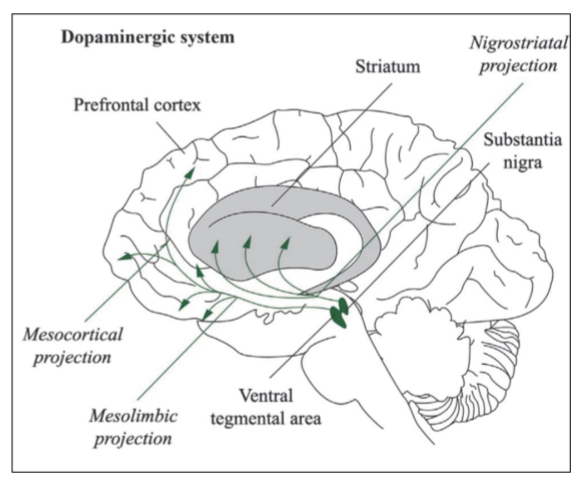
reward circuity
hijacking the reward circuitry
addiction is a brain disorder & risk for addiction is influenced by multiple factors (genes, environment, & neurochemical)
e.g., cocaine, meth
neurobiology of addiction: drug-induced euphoria occurs as a result of drug effects on the mesocorticolimbic system (mediated by increased levels of dopamine in the system)
chronic substance use can change the structure and function of the reward system and these changes can last years after a person ceases to use the substance
can result in tolerance & dependence, cravings, sensitization
alterations in frontal lobe result in distorted learning and memory:
overvaluing of the reward associated with the substance use
undervaluing the risks associated with obtaining the reward, & an inability to connect the drug use with negative consequences
sustained activation of glutamate – impacting memory & learning
evidence suggests that people with low levels of D2 receptors are at risk for addictions (e.g., drugs, food & other compulsive behaviors)
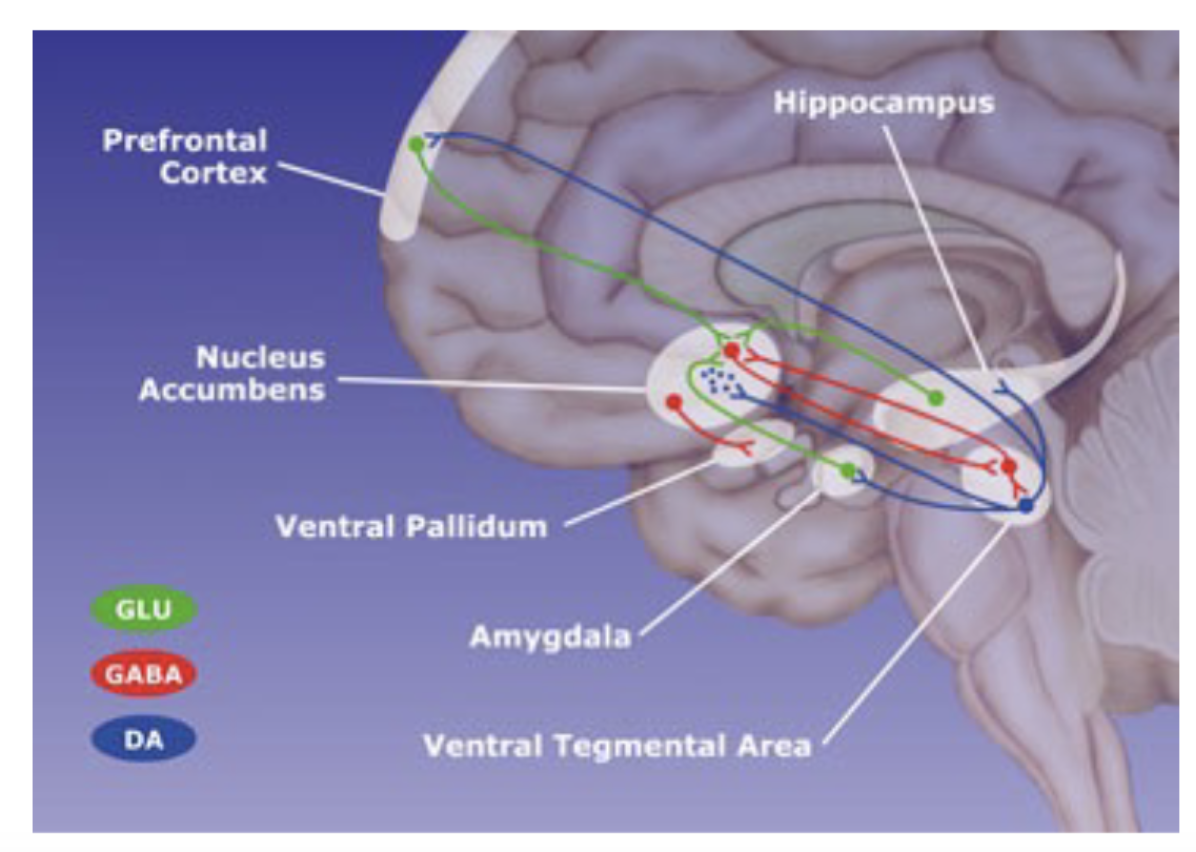
dopaminergic projections from the VTA to structures in the limbic system + prefrontal cortex
chronic substance use causes dopamine receptors to be down-regulated; dopamine function can then be reduced in the nucleus accumbens
as a result, natural rewards become less efficient at stimulating the dopamine system, and the system can become sensitized to drugs and the environmental cues associated with drugs
system can be primed by people and places that were associated with the drug use
e.g., watching people use drugs can activate the mesolimbic system for somebody with chronic substance use
drugs and diffuse modulatory systems
hallucinogens:
stimulants:
hallucinogens: LSD (lysergic acid diethylamide) – chemical structure similar to serotonin and appears to act on the serotonergic system
causes dreamlike state with heightened awareness of sensory stimuli and mixing of perceptions
current research suggests LSD causes hallucinations by overriding the naturally modulated release of serotonin in cortical areas involved in perception formation and interpretation
stimulants: cocaine and amphetamines – interact with the catecholamine systems (dopamine and norepinephrine)
both give users a feeling of increased alertness & self-confidence, sense of exhilaration & euphoria, and decreased appetite; mimic activation of the sympathetic division of the ANS
cocaine blocks reuptake of dopamine; amphetamines block reuptake of both dopamine and NE and stimulates release of dopamine
hijacks the mesocorticolimic dopamine system – reinforcing drug seeking behaviors and compulsive use